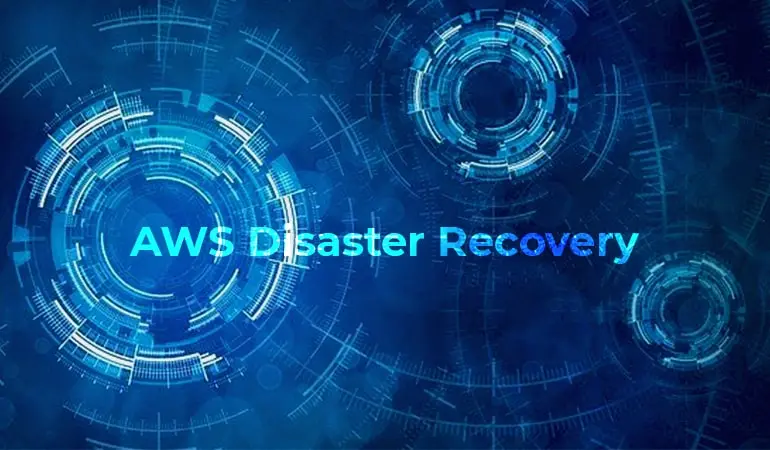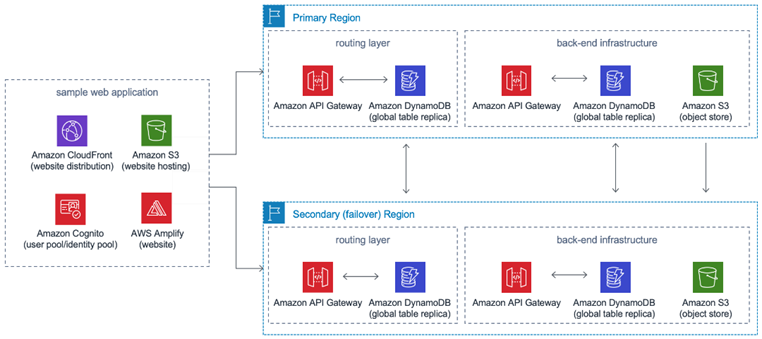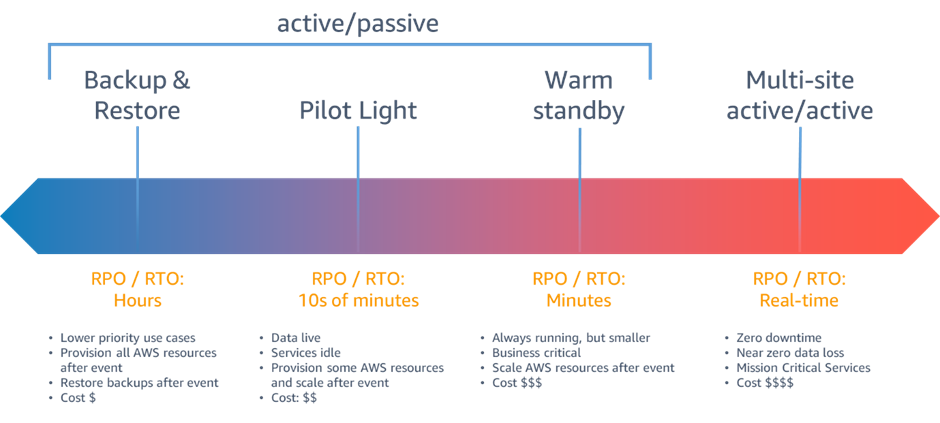
What will you do if some disaster – an unexpected power outage, a security lapse, or a natural calamity – strikes your IT infrastructure? Disaster recovery (DR) strategies are what help you cope with such events. And to ensure that you are prepared for unforeseen circumstances, you must first learn about your options.
AWS provides a range of disaster recovery (DR) strategies to help ensure the availability of your applications and data in the event of an unplanned outage. Here are some common disaster recovery strategies in Amazon Web Services AWS that you must know about.

Backup and Restore: Protect Your Data in Case of a Disaster
AWS provides several backups and restore services that can help you protect your data in case of a disaster. You can ensure the all-time availability of your data by creating a regular backup schedule and automating the restore process.
Some of the backup and restore services available on AWS include the following:
- AWS Backup
- Amazon S3 Glacier
- Amazon EBS snapshots
Multi-Availability Zone (AZ) Deployment: Ensure High Availability and Fault Tolerance
Deploying your application or service across multiple Availability Zones (AZs) in a region can provide high availability and fault tolerance. By distributing your resources across multiple AZs, you can ensure that your application or service remains available even if one AZ goes down.
You can achieve this by utilizing the following AWS services:
- Elastic Load Balancing (ELB)
- Amazon RDS Multi-AZ
- Amazon EC2 Auto Scaling
Multi-Region Deployment: Protect Against Regional Disasters

Deploying your application or service across multiple regions can provide additional protection against disasters. By replicating your data and resources across multiple regions in DevOps, you can ensure that your application or service remains available even if an entire region goes down.
You can achieve this by utilizing the following AWS services:
- Amazon Route 53
- AWS Global Accelerator
- AWS CloudFront
Load Balancing: Distribute Traffic Across Multiple Instances or AZs
AWS Elastic Load Balancing (ELB) can distribute traffic across multiple instances or AZs (Availability Zones), providing load balancing and redundancy in case of a disaster. By distributing traffic across multiple instances or AZs, ELB can ensure that your application or service remains available even if one instance or AZ goes down.
You can do this by using the following AWS services:
- Elastic Load Balancer (ELB)
- Application Load Balancer (ALB)
- Network Load Balancer (NLB)
Auto Scaling: Automatically Adjust the Number of Instances Based on Demand
AWS Auto Scaling automatically adjusts the number of instances in your deployment based on demand. By monitoring your application or service and adjusting the number of instances accordingly, Auto Scaling can ensure that your mobile apps or service remains available even if one instance goes down.
Use the following AWS services to achieve this:
- Amazon EC2 Auto Scaling
- Amazon ECS Auto Scaling
- Amazon DynamoDB Auto Scaling
Disaster Recovery (DR) Testing: Regularly Test Your Disaster Recovery Plan
It is crucial to regularly test your disaster recovery plan to ensure that it is effective and up to date. AWS provides a range of testing tools, such as AWS CloudFormation and AWS CloudTrail, to help you test your disaster recovery plan.
By regularly testing your disaster recovery plan, you can ensure that your application or service remains available even in the event of a disaster.
Using AWS Services for Disaster Recovery: Automate Your Disaster Recovery Plan
AWS cloud provides a range of services that can help you implement and manage your disaster recovery plan. By leveraging these services, you can automate many of the tasks involved in disaster recovery, such as deploying new instances and restoring backups.
Some of the services that can be used for disaster recovery on AWS are as follows:
- AWS CloudFormation
- AWS CloudTrail
- AWS Config
AWS Disaster Recovery Strategies

- One disaster recovery strategy on AWS is Backup and Restore. With a Recovery Point Objective (RPO) in hours and a Recovery Time Objective (RTO) in 24 hours or less, this strategy involves backing up data and applications in the DR region and restoring them when needed to recover from a disaster. AWS provides several backups and restores services, such as AWS Backup, Amazon S3 Glacier, and Amazon EBS snapshots.
- Another strategy is the Pilot Light approach, with an RPO in minutes and an RTO in hours. This involves keeping a minimal version of the environment by always running the most critical core elements of the system in the DR region. When recovery is required, a full-scale production environment can be quickly provisioned that includes the essential core.
- The Warm Standby approach has an RPO in seconds and an RTO in minutes. It involves keeping a reduced version of a fully functional environment always running in the DR region. Business critical systems are fully duplicated and always on, but with a reduced fleet. When recovery is needed, the system scales quickly to process the production load
- The Active-Active approach has an RPO of none or possibly seconds and an RTO in seconds. This strategy deploys the workload and actively serves traffic from multiple AWS regions. It requires synchronizing users and data between regions. When recovery time comes, services such as Amazon Route 53 or AWS Global Accelerator are used to route user traffic to the entire workload location.
Conclusion
AWS provides a range of disaster recovery (DR) strategies to help organizations ensure business continuity in the event of a disaster. Choosing the right DR strategy depends on an organization’s specific needs and requirements.
It’s important to assess each strategy’s cost, RPO (Recovery Point Objective), and RTO (Recovery Time Objective) before deciding which one to implement. Additionally, regular testing and validation of the DR strategy are crucial to ensure it will work as expected in case of a disaster. Overall, AWS Disaster Recovery Strategies strategies provide organizations with reliable and scalable solutions to ensure business continuity comes to a disaster.
Xavor is a proud AWS partner. Our AWS Services help you leverage the power of cloud computing. Contact us at [email protected] today to book a FREE consultation session with our experienced Cloud & DevOps team.
